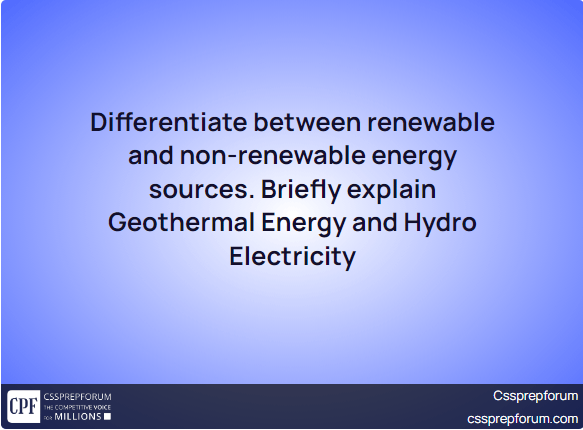The General Science and Ability Past Paper Question has been attempted by Sameeullah Kakar, a CSS English and Compulsory Course student.
CSS Solved GSA Question Paper 2020 | Differentiate between renewable and non-renewable energy sources. Briefly explain Geothermal Energy and Hydro Electricity.
Answer
Energy
The ability to cause a change of any kind is called energy. Existing in many ways, it can be in the form of heat, light, electricity, etc.
Renewable Energy sources
The energy sources providing a constant, sustainable, and endless amount of energy per unit of time are called renewable energy resources. However, they are also known as clean or alternative energy sources, for they provide energy alternatives to the commonly used energy sources, like coal and natural gas. Nevertheless, renewable energy resources do contribute to the production of electricity; moreover, according to a report, they generate 26% of the total amount of electricity produced globally. Additionally, their use helps in harvesting global warming, along with climate change and, above all, pollution. Still, it can also effectively sustain the ever-increasing requirement of energy in the form of electricity. The renewable energy resources, above all, include solar, wind, hydropower, and geothermal energy.

1- Wind energy
The wind is used to produce energy and to turn turbines for the production of electricity. Similarly, wind rotates the blades of a turbine that helps to operate a generator. On operation, the generator, as a result, produces electricity. Thus, the generator converts mechanical energy possessed by the wind into electrical energy. However, wind energy plants are usually installed near seashores or in areas with sufficient wind flow.
2- Solar energy
The radiations coming from the sun are a source of energy. Moreover, photovoltaic cells are used to convert sunlight into electricity. A single cell generates less energy but is enough to operate a small size calculator. If the cells are used collectively in a large number to produce electricity, they can run a tube well and extract water from the earth. However, the technique is used in far-sighted villages.
3- Biomass energy
The energy obtained from organic materials, such as sewage, wood, and ethanol, is termed as biomass energy. However, organic materials are obtained from plants and animals. On burning, biomass releases a sufficient amount of heat energy used to accomplish several objectives, like the production of electricity, burning of brick and cement. According to a report, the United States of America completely fulfilled the electricity requirement from biomass in the 1980s.
4- Geothermal energy
Heat present in the sub-surface of the earth is known as geothermal energy. It is found in the fluids and rocks below the earth’s crust until the Magma’s molten rocks. To use the heat, wells are dug to access the reservoirs of hot water and steam. As a result, steam and hot water are used to rotate turbines. Finally, the turbines are connected directly to the electric generators that produce electricity. However, there are three types of geothermal power plants:
- Dry steam takes steam directly from the ground.
- Flash using hot water extracted from the earth.
- Binary using hot water to boil another liquid with low boiling for the formation of steam or vapours.
5- Hydroelectricity
The electricity produced through the use of mechanical energy from moving water is called hydroelectricity. In this method, turbines are placed in moving or falling water, especially in the path of a river or a dam, rotating the turbine. However, water is sometimes stored in dams and led downward through pipes. The pipes contain turbines at the end, which rotates because of the flow of water. In consequence, the electric generators connected to the turbines produce electricity.
Non-renewable Energy sources
Finite and organic sources of energy decreasing in concentration with their use are called non-renewable energy resources. Therefore, they are also termed as also known as fossil fuels. However, the resources are organic and usually found as gases, liquids, or solids; additionally, the resources in the earth are finite in amount and concentration. Moreover, if the resources are utilized, they cannot be replaced by any means as they take billions of years to replace supplies used from the resources- a threatening problem for mankind. Above all, the sources can be maintained with low maintenance charges and high production quantity.
Examples:
Crude oil, natural gas, and coal
1- Crude oil
Crude oil- the first type of fossil fuel- is made up of hydrocarbons and other organic materials. However, it is usually refined in factories to produce petroleum, gasoline, diesel, and several petrochemicals. All the products are used in different industries, like transportation and manufacturing industries.
2- Natural gas
Natural gas is another type of fossil fuel occurring known as a hydrocarbon gas. It includes Methane, alkanes, Carbon-di-Oxide, Nitrogen, Hydrogen sulphide, and Helium gas. However, the percentage of Methane in natural gas varies from 70 to 90% of the natural gas. Moreover, it is found beneath the earth’s surface from the decay of animals and other creatures.
3- Coal
Coal- a carbonium compound- is a hard solid substance found in the mountains. It has a high percentage of carbon; Moreover, the rate of carbon components in coal varies from 70% to 75%. It is usually found in both black and brown colours. However, it is used to produce heat in industries, such as the brick and cement industry. It is formed by the decomposition of trees and animal remains beneath the earth’s surface in the absence of air and oxygen.
Differentiation chart
| S. No | Criteria | Renewable energy sources | Non-renewable energy sources |
| 1 | Use | Can be used repetitively | Can be used one time only |
| 2 | Type of sources | Can be used perpetually | Can vanish one day |
| 3 | Eco friendly | They are eco-friendly | They are not eco-friendly |
| 4 | Concentration | unlimited | Limited |
| 5 | Maintenance | High | Low |
| 6 | Production cost | Large | Less |
| 7 | Examples | Wind, solar, and biomass energy | Coal, crude oil, and natural gas |
Are you looking to learn English communication skills to qualify for the CSS and PMS English essay & Precis papers? Let’s join Sir Syed Kazim Ali and learn how to give your ideas and thoughts words, fluently and confidently.
CSS & PMS 2024 Extensive English Course

A quick recipe to score up to 90 marks in CSS GSA paper by Sir Auzair Mehmood
Having taught for many years in different universities and being an experienced lecturer, I have devised a strategy for my CSS and PMS students, who aim to score up to 90 marks in the CSS GSA paper. Unfortunately, due to a large number of CSS and PMS aspirants, a very busy schedule, and Sir Syed Kazim Ali‘s rule of taking a limited number of students in CSS English and Compulsory Course to ensure quality rather than quantity and remain the best e-institute, I cannot teach all student. However, under the guidance of Sir Kazim, I have decided to highlight the best strategies that I teach my students to score maximum marks in the paper. All the students may follow them to pass the CSS GSA paper with flying colours. Moreover, to help thousands of CSS aspirants, I have created a separate category where I have uploaded the last 30 years of CSS GSA Solved Past Papers. Or, you can also visit the category GSA Notes, where my students publish their write-ups related to CSS GSA papers.
- Science is not a subject to cram. Therefore, aspirants must not cram the study material but try to grab the concepts and reproduce them on the paper in accordance to the requirements of the question.
- Rather than memorizing and reproducing the content from different sources, students must learn to give their thought words properly, coherently, affectively, and grammatically correct. This gives a pleasant and unique feeling to the examiner as he is always desperate to find the original and unique thoughts out of thousands of papers, and he always appreciates such aspirants by giving maximum marks.
- For preparing General Science, students must practice diagrams with as much topics as possible and reproduce them on the paper, for diagrams, illustrations, and graphs boost the score of the candidate.
- It is commonly observed that students take the MCQs portion very light. However, 20 marks of MCQs are very important as they not only boost the score but also morale of the student. Therefore, aspirants must give due attention and time to the preparation of MCQs portion. Fortunately, Howfiv is the only platform, where an aspirant can find millions of MCQs, along with their explanation, of all the subjects, including GSA, and MCQs should be prepared from Howfiv.
- Furthermore, Ability and Mathematics portion is critical and decisive for the future of a CSS and PMS aspirant. With a little effort and focus, an aspirant can grab full marks in this portion. Therefore, an aspirant must practice different mathematical skills throughout his preparation for the exam.
- Last but not the least, practicing the past papers and getting them evaluated by an expert teacher or lecturer, rather than mere a CSS or PMS qualifier, is the key to achieve up to 90 marks in CSS GSA paper.













